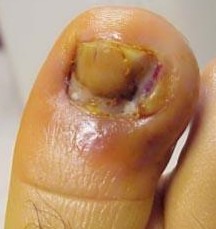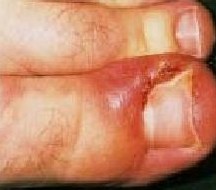Ingrown Toenail(s) Infection
An ingrown toenail occurs when the nail grows down and into the skin of the toe. It is caused by abnormal growth of the toenails, usually the big toes, and the surrounding tissues. When the lateral edges of the nail grow into the flesh of the toe, the small piece of nail or the whole nail applies pressure on the skin resulting in pain, swelling and redness. If the condition persists, it results in infection and inflammation. Patients with ingrown toenails are among the most common visitors to chiropodists or podiatrists.
The condition of ingrown toenails is known by various terms like toe infection, nail infection, ingrown nail or onychocryptosis. Infected ingrown toenail is a very common problem affecting primarily the big toenails. Most people develop an ingrown toenail big toe during their 20s and 30s. It is also seen in teenagers in case of a tearing in the corners of their toenails. It is not often seen in children or infants.
The sideways growth of the nail edges into the skin of the toe causing discomfort. The abnormally growing nail acts like a foreign body and causes a break in the skin due to the constant poking. The ingrown nail can also apply pressure in the nail fold area without any skin penetration causing pain though it isn’t considered as ingrown toenail. In some cases, a corn/callus is also noticed down the side of the nail as a reaction to the pressure instead of the nail actually penetrating the skin.
Ingrown Toenail Symptoms
Symptoms of ingrown toenail include sore and painful nail folds with redness and swelling of the surrounding skin. Infection of tissue and tenderness in toe along the sides of the nail and pain is observed along with increased warmth. In a few cases where the condition is chronic, repeated episodes of pain and infection or one of these occur. An infection may be present if the skin is red, painful or swollen on the sides of the nail. This infection may cause complications for diabetics or other patients due to poor circulation of blood on their feet. If left untreated, the nail can go under the skin causing more severe ingrown toenail infections.
An examination of the infected foot may show skin which is swollen, firm, red, or tender to touch. Presence of pus in ingrown toenails is also reported in some cases. Skin along the edge of the nail appears to be growing over the nail.
Ingrown Toenail Causes
An ingrown toenail can develop due to various reasons like poorly fitting shoes and toenails that are not trimmed the right way. Cutting the toenails incorrectly, too short or not straight across causes them to re-grow into the skin. Tight hosiery or footwear with narrow toe boxes makes it even worse. Repetitive activity such as kicking a soccer ball can cause an ingrown toenail.[5]
Injuries to the toenail or a broken toe or deformities of the foot or toes like unusually thick toenails and curved toenails are also the factors for an ingrown toenail. It can also be hereditary in some cases.
Ingrown Toenail Risk Factors
The risk factors for ingrown toenails include poor fitted footwear, poor foot hygiene, athletic adolescents and children, toenail infections, diabetes, obesity, naturally short nails, congenital foot deformity and congenital toenail malformation. Repeated injuries to foot, prior nail surgery, poor posture and gait, fungal nail disease, abnormal nail growths, arthritis and excessive foot sweating are also some of the other risk factors.
Persons with very long toes and also those born with curved nails that tend to grow downward are also prone to ingrown toenails. Anyone can develop this condition but adults are more prone to suffer because the nails tend to thicken with age. Children and infants do not often have ingrown toenails. These are more common with men than with women and the most frequently affected toe is the big toe. [6]
Ingrown Toenail Pictures
Source: kirkintillochfootclinic.co.uk

Source: kirkintillochfootclinic.co.uk

Ingrown Toenail Remedies
How to get rid of an ingrown toenail?
This condition can be resolved without medical treatment unless it’s a complicated case where a physician is required for treatment. An ingrown toenail can be unpleasant and painful. Multiple home remedies for ingrown toenails are known.
Keep your toe clean at all times if you have an ingrown toenail. If your skin is broken, be sure to keep a clean non-stick dressing on your toe. Try to keep it all clean to prevent infection. If your ingrown toenail becomes infected you need to get professional medical help. They might give you antibiotics to minimize or stop the infection.
- One simple approach is to prepare a basin with warm water to soak your foot in after you have added a tablespoon of salt. This will work like a natural disinfectant. It also heals the skin around the wounded toe. Then use a soft towel to pat your foot dry. The next step is to put a small ball of cotton wool into a thin thread so you can wedge it under the ingrown toenail. Another alternative is to use waxed dental floss for that purpose. Repeat the entire process each evening, until the nail begins to grow outward.
- Another method is to use a slice of lemon tied around the sore toe. It is the acid from the lemon that prevents the infection from spreading.
- Some people use a solution of water and hydrogen peroxide or iodine to wash the infected area.
- Tea tree oil can soften the nail tissue and relieve pain. Massaging the skin near the toenail can relieve can ease the pressure on the nail.
These home remedies for ingrown toenail, however, work only as long as an infection doesn’t develop. When an infection is observed, it becomes essential to see a podiatrist as soon as possible. If the wound continues to go deeper, more complications can result. If you have diabetes or other health conditions which affect your blood circulation, you should never treat an ingrown toenail on your own. See the doctor right away.
Ingrown Toenail Treatment
When an ingrown toenail infection is found, immediate treatment is necessary otherwise it may lead to other infections. Here are a few tips on how to treat ingrown toenail?
In an early stage, as part of ingrown toenail home treatment, the pain and swelling can be relieved by soaking the foot in warm water and adding some Epsom salt to it. Epsom salt, being an antiseptic, will heal any signs of mild infection.
Tight socks, hose or shoes should be avoided as these tend to put pressure on the toenails.
Shoes that are broad at the base should be preferred as they are comfortable to wear. In case of an infection, open-toed sandals are the best. Wear socks to keep your feet covered to prevent infection.
Avoid painting the toenails while they are ingrown. Any unnecessary chemicals near the site may cause infection.
For cutting your nails, the toenail clippers should be used. Toenails should not be kept too short.
Always trim the toenails in a perfectly straight line. Do not ever try shaping them because that makes them more likely to become ingrown.
For fast pain relief, ibuprofen or acetaminophen can be used.
Placing a small cotton ball under the ingrown nail will work to keep the affected area safe. This will also help in nail grow and reaching over the skin. The cotton should be changed daily so as to keep a check on infectious growth. Also refer to some of the home remedies mentioned above.
Once affected, there is a great possibility that it will happen again. Therefore you need to do whatever you can to prevent it. Toenails are very susceptible to infections when they are ingrown, so do your best to keep it covered and clean for ingrown toenail relie and prevention.
For treating ingrown toenail, the cotton method or waxed dental floss method should always be applied along with antibiotics. The combination is important because the antibiotic will reduce the infection yet it cannot help the nail grow back properly.
Ingrown Toenail Surgery
If the ingrown toenail condition is not cured by home remedies or treatments and it keeps recurring, surgery becomes mandatory as the final ingrown toenail treatment. An ingrown toenail surgery is minor and involves a simple procedure.
A local anesthesia will be administered before the surgery. The toe is cleaned with antiseptic to prevent infection. Then the nail will be loosened and removed using a scalpel.
In mild cases, only an edge of the nail may be removed without disturbing the nail bed. However, in some cases, the entire nail will be removed. Then the nail bed cells are killed by liquefied phenol or a laser or a surgical debriding. The nail won’t ever grow back because the nail bed cells have been killed.
The toe is dressed with a non-stick paraffin gauze and crepe bandage. The foot should be kept elevated. The patient should rest for 2-3 days. If the ingrown toenail is removed, it will take about 3-4 months for the nail to grow again.
The cost of ingrown toenail surgery is usually affordable and it varies according to the time required for treatment and severity of the wound.
References:
- http://www.foothealthfacts.org/footankleinfo/ingrown-toenail.htm
- http://en.wikipedia.org/wiki/Ingrown_nail
- http://www.medicinenet.com/ingrown_toenail/article.htm
- http://www.epodiatry.com/ingrown_nails.htm
- http://www.emedicinehealth.com/ingrown_toenails/article_em.htm


Excellent post – very informative. Ingrown toenails can become infected if left untreated and can be very painful.
Ingrown toenail’s often re-occur, it is best to seek professional treatment from your GP or a podiatrist.
i have ingrown toe nail but can someone explain to me the cotton part what do i do
Hello Eric, The cotton is to raise the nail and “hopefully” let it grow out. I tried it but it didn’t solve the problem. I also disagree with the diagram on this page showing the “ingrown” nail as “U” shaped. I think most people, including myself, have normal nails that we just cut back too far at one point in our lives. Now, trying to allow them to grow out (read grow through the skin) is excruciating. When we can’t bear it any longer, we cut them back, and start the vicious cycle all over again… for ever and ever. If you want to know what is working miracles for me, write me mh__98 (that’s two underscores)at yahoo dot com. Honest, no spam, just relief!
Eric, make sure you keep your toe clean and keep a dressing on it if the skin is broken. The best sort of dressing are non lint ones which will not stick to the skin. This will help reduce the risk of infection, as if it becomes infected you will need to seek the attention of your podiatrist who may be able to offer you anti-biotics to reduce the infection.
I tried them all… cutting “V”s, cotton, etc. The best thing I ever did for myself was to use some small plastic straws (coffee stirrers), split down the side, as splints. Try it. MH